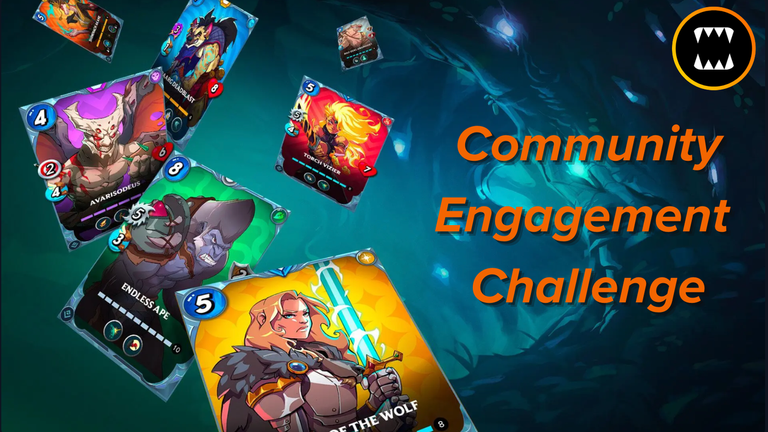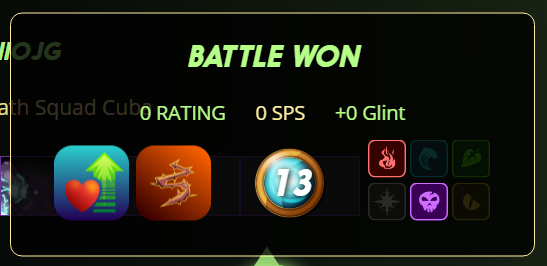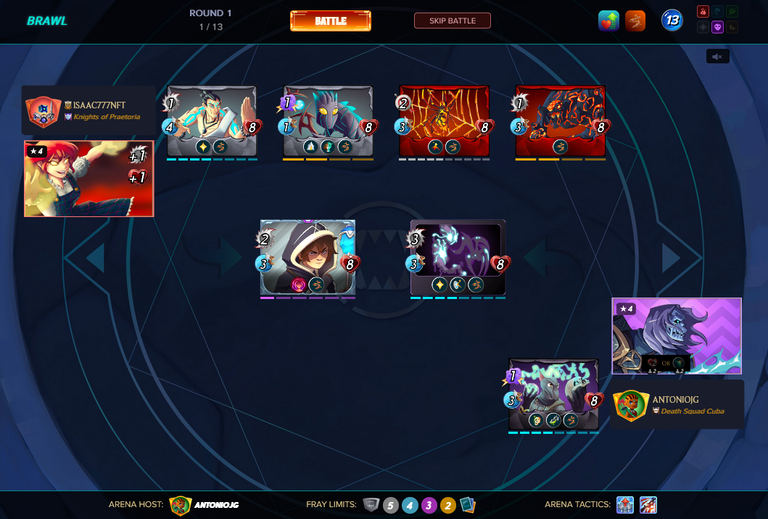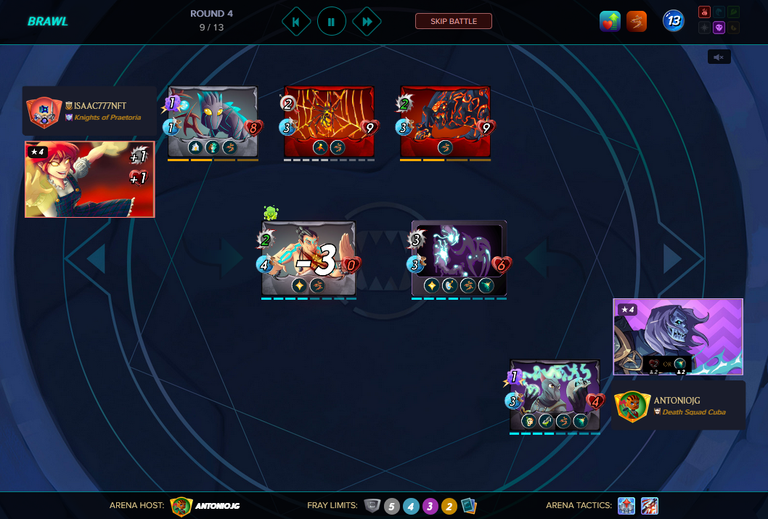
Español
¡Saludos comunidad! En el reto de esta semana quiero compartir con ustedes un análisis de mi experiencia utilizando una estrategia con las tácticas de invocadores y el Splinter de Muerte. La cual considero una excelente opción para aquellas partidas con un límite de maná bajo y con el ruleset “Briar Patch”. Es importante recordar que el tipo de ofensiva a utilizar en nuestras estrategias también dependerá del resto de reglas presentes en la batalla.
En esta oportunidad, les explicaré cómo afronté una batalla de Brawl de la liga de Plata en el formato Salvaje, enfocando mi análisis en explicar cómo utilicé al Splinter de Muerte, el invocador Reklah y a las unidades Haunted Spirit y Venari Bonesmith para ser coherente con las reglas de batalla presentes y las habilidades que quería combinar con la finalidad de tomar ventaja en la partida con la estrategia planteada.
Ya que estos aspectos son un factor clave con un impacto considerable en el desempeño de nuestras estrategias.

Conjunto de reglas y elección

Límite de maná igual a 13 puntos, esta cantidad nos permite elegir invocadores con un costo de maná entre 4 y 7 puntos. Sin embargo, es importante tener una estrategia bien definida para aprovechar sabiamente los puntos de maná restantes.
Equalizer, es una regla que iguala los puntos de vida de todas las unidades a la cantidad más alta de vida entre ambos equipos. Por otra parte, Briar Patch, otorga a todas las unidades la habilidad “Thorns”.
Entonces, tomando en cuenta todos estos aspectos, decidí utilizar al Splinter de Muerte, ya que cuenta con unidades que poseen buenas estadísticas, entre ellas, un buen daño melee y mágico. También cuenta con habilidades como: “Heal”,”Life Leech”, “Poison”, “Magic Reflect”, entre otras y con un invocador que posee la mecánica “Tácticas de Invocadores”, donde nos permite elegir, si otorgar la habilidad “Reflection Shield” a dos de nuestras unidades o reducir en dos puntos la vida de dos unidades enemigas.

Equipo y estrategia

Hablemos sobre el equipo y la estrategia que conforma. Dadas las circunstancias, era evidente el uso de cualquier tipo de ataque. Es por ello que decidí elegir al invocador Reklah, ya que posee la mecánica “Tácticas de Invocadores”, donde nos permite elegir, si otorgar la habilidad “Reflection Shield” a dos de nuestras unidades o reducir en dos puntos la vida de dos unidades enemigas.
Dadas las circunstancias, decidí otorgar la habilidad “Reflection Shield” a mis 2 unidades para evitar el daño de la habilidad “Thorns”.
Haunted Spirit fue el tanque en esta oportunidad, ya que cuenta con buenas estadísticas, entre ellas, sus puntos de vida, velocidad y ataque melee. También posee las habilidades “Heal” y “Magic Reflect”, las cuales le permiten resistir un poco más el daño enemigo y retornar parte del daño mágico recibido.
Por otra parte, Venari Bonesmith se encarga de otorgar cierta ventaja al equipo, una vez aplica la habilidad “Poison”. Además, tiene la posibilidad de incrementar sus puntos de vida a través de la habilidad “Life Leech”.
Entonces, como pueden observar, la clave de la estrategia consiste en poder utilizar unidades con ataque melee y evitar los efectos de la habilidad “Thorns”, y para ello utilizamos a “Reflection Shield”.

Estrategia en acción

Como les mencioné anteriormente, elegir al invocador Reklah y a las unidades Haunted Spirit y Venari Bonesmith, fue una buena opción. Sin embargo, también es importante incluir habilidades de soporte que le permitan a nuestro tanque y al resto del equipo, resistir lo suficiente.
Observen como para el turno 9 de la ronda 4, el equipo enemigo estaba casi abatido. Haunted Spirit resistió muy bien en la primera posición, el uso de la habilidad “Reflection Shield” fue clave para ello. Del mismo modo, la contribución de Venari Bonesmith con su habilidad “Poison” para debilitar al enemigo.
Si quieres ver la batalla completa, acá te dejo el enlace: CLIC PARA VER LA BATALLA

Conclusión
La estrategia planteada hizo un uso eficiente de la cantidad de maná disponible, cubriendo aspectos tales como: resistencia contra el daño enemigo, soporte del equipo, una buena ofensiva, y coherencia con el conjunto de reglas presente.
Una debilidad de esta estrategia es un equipo enemigo que cuente con resistencia al daño melee e incluya habilidades como: “Shield”, “Protect”, “Repair”, “Demoralize”, “Heal”, “Tank Heal”, “Enrage”, “Affliction”, “Cleanse”, entre otras.
La diferencia entre las estrategias fue que el equipo enemigo no contaba con las habilidades de soporte suficientes, por lo que terminó siendo abatido a pesar de tener una mayor ofensiva.
Para el funcionamiento adecuado de nuestras estrategias, es importante considerar todos los aspectos involucrados, por lo que no sólo debemos enfocarnos en las estadísticas y habilidades a combinar. También debemos tener en cuenta la influencia de los conjuntos de reglas sobre la estrategia.
Este ha sido mi aporte al desafío semanal, ¡Espero haya sido de su agrado! ¡Saludos y hasta la próxima semana!

English
Greetings community! In this week's challenge I want to share with you an analysis of my experience using a strategy with summoner tactics and the Death Splinter. I consider it an excellent option for those games with a low mana limit and with the “Briar Patch” ruleset. It is important to remember that the type of offensive to use in our strategies will also depend on the rest of the rules present in the battle.
In this opportunity, I will explain how I faced a Silver League Brawl battle in the Wild format, focusing my analysis in explaining how I used the Death Splinter, the summoner Reklah and the units Haunted Spirit and Venari Bonesmith to be coherent with the battle rules present and the abilities I wanted to combine in order to take advantage in the game with the proposed strategy.
Since these aspects are a key factor with a considerable impact on the performance of our strategies.

Rulesets and choise

Let's talk about the set of rules present in the battle, this is the starting point to begin the analysis that will lead us to the most appropriate choice to face the battle.
Mana limit equal to 13 points, this amount allows us to choose summoners with a mana cost between 4 and 7 points. However, it is important to have a well-defined strategy to wisely use the remaining mana points.
Equalizer, is a rule that equals the life points of all units to the highest amount of life between both teams. On the other hand, Briar Patch, grants all units the ability “Thorns”.
So, taking into account all these aspects, I decided to use the Death Splinter, since it has units with good stats, including good melee and magic damage. It also has abilities such as: “Heal”, “Life Leech”, “Poison”, “Magic Reflect”, among others, and a summoner that has the “Summoner Tactics” mechanic, which allows us to choose whether to grant the “Reflection Shield” ability to two of our units or reduce the life of two enemy units by two points.

Team and strategy

Let's talk about the team and its strategy. Given the circumstances, it was evident the use of any type of attack. That's why I decided to choose the summoner Reklah, since he has the “Summoner Tactics” mechanic, which allows us to choose whether to grant the “Reflection Shield” ability to two of our units or reduce the life of two enemy units by two points.
Given the circumstances, I decided to grant the “Reflection Shield” ability to my 2 units to avoid the damage of the “Thorns” ability.
Haunted Spirit was the tank in this opportunity, since he has good stats, among them, his life points, speed and melee attack. He also has the “Heal” and “Magic Reflect” abilities, which allow him to resist enemy damage a little more and return part of the magic damage received.
On the other hand, Venari Bonesmith is in charge of giving a certain advantage to the team, once he applies the “Poison” ability. In addition, he has the possibility of increasing his life points through the “Life Leech” skill.
So, as you can see, the key to the strategy is to be able to use units with melee attack and avoid the effects of the “Thorns” ability, and for this we use “Reflection Shield”.

Strategy in action

As I mentioned before, choosing the summoner Reklah and the units Haunted Spirit and Venari Bonesmith was a good choice. However, it is also important to include support abilities that allow our tank and the rest of the team to resist enough.
Note how by turn 9 of round 4, the enemy team was almost down. Haunted Spirit resisted very well in the first position, the use of the ability “Reflection Shield” was key to this. Likewise, Venari Bonesmith's contribution with his “Poison” ability to weaken the enemy.
If you want to see the complete battle, here you have the link: CLICK TO WATCH THE BATTLE

Conclusion
The strategy proposed made efficient use of the amount of mana available, covering aspects such as: resistance against enemy damage, team support, good offense, and coherence with the present rule set.
A weakness of this strategy is an enemy team that has resistance to melee damage and includes abilities such as: “Shield”, “Protect”, “Repair”, “Demoralize”, “Heal”, “Tank Heal”, “Enrage”, “Affliction”, “Cleanse”, among others.
The difference between the strategies was that the enemy team did not have enough support skills, so they ended up being defeated despite having a greater offensive.
For the proper functioning of our strategies, it is important to consider all the aspects involved, so we should not only focus on the statistics and skills to combine. We must also take into account the influence of the rule sets on the strategy.
This has been my contribution to the weekly challenge, I hope you enjoyed it, greetings and see you next week!

Te invito a seguirme en / I invite you to follow me on: Twitter
Las traducciones fueron realizadas con el traductor / Translations were done with the translator: DeepL
Todas las imágenes fueron tomadas de / and all images were taken from: Splinterlands

The rewards earned on this comment will go directly to the people( @antoniojg ) sharing the post on Reddit as long as they are registered with @poshtoken. Sign up at https://hiveposh.com. Otherwise, rewards go to the author of the blog post.
Thanks for sharing! - @alokkumar121

¡Gracias! | Thanks! ✌️
Felicidades por esa victoria bro, he notado que estos invocadores se utilizan muy poco en el las partidas ranked, incluso en el formato moderno raras veces me he enfrentado a estos invocadores raros aunque si los legendarios, a veces pienso que los invocadores tácticos legendarios le restaron toda utilidad a los raros. Saludos.
!BBH
Epale Bro, concuerdo contigo. Antes los utilizaba poco porque eran costosos para alquilar pero ahora que están a precios más accesibles, los he estado testeando y por lo menos los tipo raro tienen mucho potencial.
Aún estoy aprendiendo a utilizar a los tipo legendario como por ejemplo: Nidhoggr.
¡Saludos!
@antoniojg! @bulkathos likes your content! so I just sent 1 BBH to your account on behalf of @bulkathos. (6/50)
(html comment removed: )
)